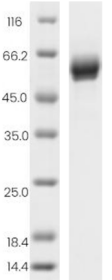Human CD160 Protein, His Tag
-
产品编号
KMP2409
-
别名
自然杀伤细胞受体BY55, CD160 antigen, CD160
-
规格
- 50ug
- 100ug
- 200ug
| Catalog Number | KMP2409 |
| Alias | 自然杀伤细胞受体BY55, CD160 antigen, CD160 |
| Size | 50ug, 100ug, 200ug |
| Product Description | The Human CD160 Protein(KMP2409) is produced in HEK293 Cells and the target gene encoding Ile27-Ser159 is expressed with a 6His tag at the C-terminus. |
| Molecular Name | CD160 |
| Product Introduction | CD160:免疫球蛋白超家族(IgSF)糖蛋白,以GPI锚定或跨膜形式表达于NK细胞毒性亚群,通过特异性配体结合参与免疫信号传导。 |
| Molecular Weight | 15.62 kDa |
| Expression System | HEK293 Cells |
| Species | Human |
| Purity | >90% |
| SDS-PAGE |  |
| Purification | Affinity Purification |
| Uniprot ID | O95971 |
| Storage Condition | Aliquot and store at -20℃ to -80℃. Avoid repeated freezing and thawing cycles. |
| Formulation | 20mM PB, 150mM NaCl, pH7.4 |
| Shipping Condition | In general, the proteins are provided as lyophilized powder which are shipped at ambient temperature. They are shipped out in dry ice if supplied in liquid form. |
| Background | CD160 antigen is a Lipid-anchor that exists as a disulfide-linked homomultimer. CD160 contains one Ig-like V-type domain. The human CD160 precursor is a cysteine-rich, glycosylphosphatidylinositol-anchored protein of 181 amino acids with a single Ig-like domain. It is weakly homologous to KIR2DL4. CD160 is expressed in the spleen, peripheral blood, and small intestine. Its expression is tightly associated with peripheral blood NK cells and CD8 T lymphocytes with cytolytic effector activity. CD160 is a receptor showing broad specificity for both classical and non-classical MHC class I molecules. |
| Endotoxin | <1.0 EU/ug determined by the LAL method |
| Product Declaration | 该产品仅供科研使用,不可直接用于人体或注射。 |
低速离心:12,000 rpm, 5分钟,去除不溶物。缓冲液置换:使用超滤离心管(如10 kDa截留分子量)浓缩。
可优化表达条件(如降低诱导温度、调整IPTG浓度)、使用促溶标签(如SUMO、GST)、共表达分子伴侣,或尝试不同宿主系统(如哺乳动物细胞或昆虫细胞)以提高可溶性蛋白产量。





 0
0
